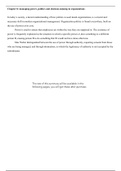Samenvatting
Summary - Chapter 8 9 - Managing and Organizations 5th edition - Organization Theory
- Instelling
- Vrije Universiteit Amsterdam (VU)
Summary - Chapter 8 9 *As shown, the summaries of all 2 chapters consist of a total of 3 pages, so these are NOT comprehensive summaries. However they clearly show and explain the main thoughts and topics.
[Meer zien]





